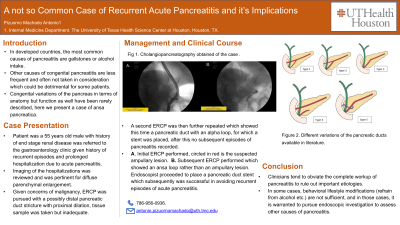Sunday Poster Session
Category: Biliary/Pancreas
P0071 - A Not so Common Case of Recurrent Acute Pancreatitis and Its Implications
Sunday, October 22, 2023
3:30 PM - 7:00 PM PT
Location: Exhibit Hall

Has Audio

Antonio Pizuorno Machado, MD
University of Texas Health Science Center
Houston, TX
Presenting Author(s)
Antonio Pizuorno Machado, MD
University of Texas Health Science Center, Houston, TX
Introduction: Acute pancreatitis is a common entity in developed countries such as in the United States. Both genetic and environmental factors might contribute to the pathogenesis of this disease; congenital causes represent a minimal share in the cause of this pathology and not typically suspected or investigated. Congenital variations in both the anatomy and function of the pancreas are still infrequent but possible; we present this time a case of ansa pancreatica which is a extremely rare entity as a cause of recurrent acute pancreatitis.
Case Description/Methods: Patient is a 55 years old male with past medical history of hypertension and end stage renal disease with extensive history of pancreatitis. He was referred to the gastroenterology clinic given the prolonged history of admissions due to pancreatitis; he was recommended in the past a trial of CREON with meals with no success. His hospitalizations consisted of the classical symptoms of pancreatitis along with elevations of lipase up to 21000, patient did not had any previous imaging finding besides of CT scans that were pertinent only for acute pancreatitis on each admission. In clinic, decision was made to further proceed with ERCP with an initial pertinent for a distal pancreatic duct stricture with proximal dilatation concerning for possible pancreatic neoplasm versus ampullary neoplasm for which biopsy was taken; the biopsies were reported to be insufficient reason for which decision was made to repeat another ERCP which reported to have a pancreatic duct appeared to have an alpha loop. Duct was dilated up to 7 mm in head of pancreas with smooth distal tapering and side branches, due to this a pancreatic duct stent was placed. Final biopsies were completely negative and formal diagnosis of ansa pancreatica was made as the predisposing factor for the chronic pancreatitis. After the placement of the stent patient did not had any subsequent episodes of pancreatitis recorded.
Discussion: Although pancreatitis might be a common reason for admission to the hospital, frequent episodes of pancreatitis evolving to chronic pancreatic are not commonly seen. Given the multifactorial etiology of this entity, clinicians tend to obviate further workup to rule out secondary (and less common causes) of this disease. In this case we describe a patient with a pertinent diagnosis of ansa pancreatica whom would have benefit from stent placement previously if the patient would have had proper workup with imaging such as MRCP.

Disclosures:
Antonio Pizuorno Machado, MD. P0071 - A Not so Common Case of Recurrent Acute Pancreatitis and Its Implications, ACG 2023 Annual Scientific Meeting Abstracts. Vancouver, BC, Canada: American College of Gastroenterology.
University of Texas Health Science Center, Houston, TX
Introduction: Acute pancreatitis is a common entity in developed countries such as in the United States. Both genetic and environmental factors might contribute to the pathogenesis of this disease; congenital causes represent a minimal share in the cause of this pathology and not typically suspected or investigated. Congenital variations in both the anatomy and function of the pancreas are still infrequent but possible; we present this time a case of ansa pancreatica which is a extremely rare entity as a cause of recurrent acute pancreatitis.
Case Description/Methods: Patient is a 55 years old male with past medical history of hypertension and end stage renal disease with extensive history of pancreatitis. He was referred to the gastroenterology clinic given the prolonged history of admissions due to pancreatitis; he was recommended in the past a trial of CREON with meals with no success. His hospitalizations consisted of the classical symptoms of pancreatitis along with elevations of lipase up to 21000, patient did not had any previous imaging finding besides of CT scans that were pertinent only for acute pancreatitis on each admission. In clinic, decision was made to further proceed with ERCP with an initial pertinent for a distal pancreatic duct stricture with proximal dilatation concerning for possible pancreatic neoplasm versus ampullary neoplasm for which biopsy was taken; the biopsies were reported to be insufficient reason for which decision was made to repeat another ERCP which reported to have a pancreatic duct appeared to have an alpha loop. Duct was dilated up to 7 mm in head of pancreas with smooth distal tapering and side branches, due to this a pancreatic duct stent was placed. Final biopsies were completely negative and formal diagnosis of ansa pancreatica was made as the predisposing factor for the chronic pancreatitis. After the placement of the stent patient did not had any subsequent episodes of pancreatitis recorded.
Discussion: Although pancreatitis might be a common reason for admission to the hospital, frequent episodes of pancreatitis evolving to chronic pancreatic are not commonly seen. Given the multifactorial etiology of this entity, clinicians tend to obviate further workup to rule out secondary (and less common causes) of this disease. In this case we describe a patient with a pertinent diagnosis of ansa pancreatica whom would have benefit from stent placement previously if the patient would have had proper workup with imaging such as MRCP.

Figure: A. Impression on initial ERCP performed on patient at the first episode of pancreatitis, circled in red is highlighted the suspected ampullary lesion which was initially biopsied with insufficient sample to have a diagnosis.
B. Subsequent ERCP performed in next acute pancreatitis episode which showed what was a ansa loop rather than an ampullary lesion. Endoscopist proceeded to place a pancreatic duct stent which subsequently was successful in avoiding recurrent episodes of acute pancreatitis.
B. Subsequent ERCP performed in next acute pancreatitis episode which showed what was a ansa loop rather than an ampullary lesion. Endoscopist proceeded to place a pancreatic duct stent which subsequently was successful in avoiding recurrent episodes of acute pancreatitis.
Disclosures:
Antonio Pizuorno Machado indicated no relevant financial relationships.
Antonio Pizuorno Machado, MD. P0071 - A Not so Common Case of Recurrent Acute Pancreatitis and Its Implications, ACG 2023 Annual Scientific Meeting Abstracts. Vancouver, BC, Canada: American College of Gastroenterology.
